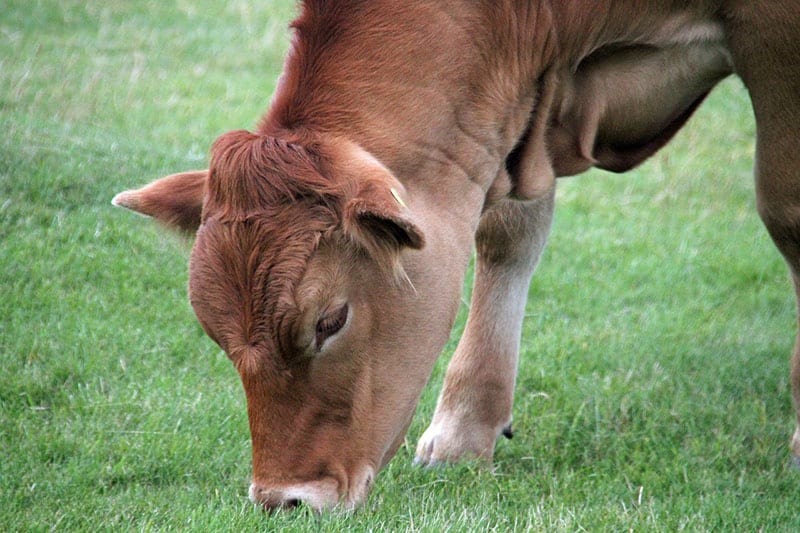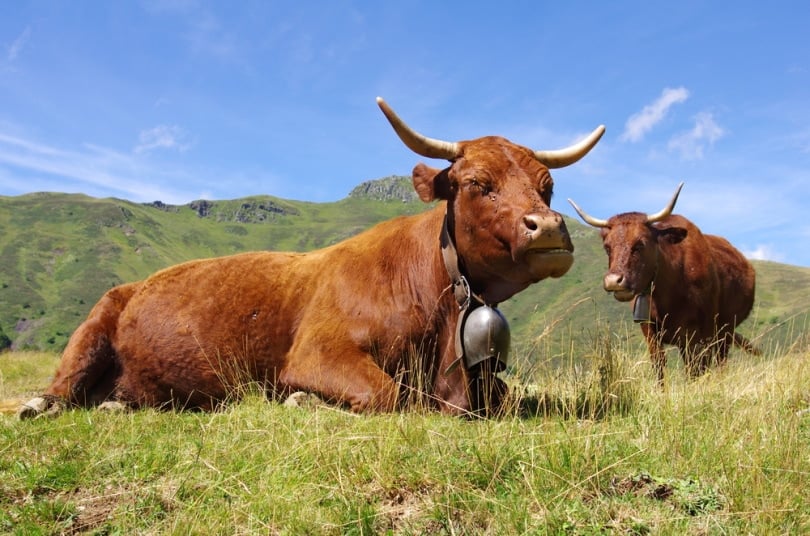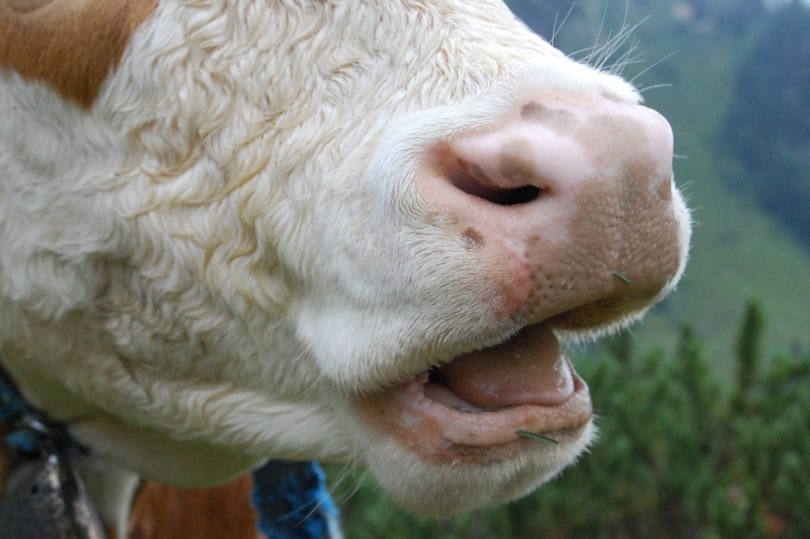Cows are magnificent and gentle creatures that many people love having at home. The estimation is that there were one billion cows in the world as of 2020. With that in mind, it’s best to understand a few things about them; for instance, do they have top teeth?
Yes, cows do have top teeth. However, they’re missing the upper front teeth. All cows don’t have the two upper incisors teeth like other animals. Instead, dental padding in this area is quite useful to them.
Therefore, don’t be alarmed when you notice your cow doesn’t have the upper front teeth. Stick around, and let’s get to know why cows don’t have them and other interesting facts.

Which Teeth Do Cows Miss?
Teeth are quite essential to animals and human beings. Many animals wouldn’t eat any food if they didn’t have teeth. Those missing their teeth can starve if something isn’t done to remedy the issue.
However, as crucial as teeth are, other animals, such as cows, lack some teeth, which is normal. They do have teeth on the upper and lower parts of their jaws. But they don’t have the two upper incisors.
Now, before you panic, know that this is okay. That’s how cows are, and the missing teeth do help them function better. Instead of these teeth, cows have a dental pad. This pad helps them eat more food or hold on to more grass while grazing.
So, while other animals have longer canines to grab food, cows lack them for the same purpose. Once the cows grab lots of grass, it’s the work of the molars at the back to grind it up. Then the food moves into the digestive system.


How Many Teeth Do Cows Have?
Did you know that a healthy adult cow has a total of 32 teeth despite missing two upper incisors in its mouth? All these teeth play an essential role in helping the animal eat and digest its food.
Cows might have a unique dental arrangement, but they still have similar teeth to other animals. An adult cow has a total of 32 teeth, as mentioned above. These include incisors, molars and premolars.
These majestic animals only have incisors on the front lower part of the jaw. The upper part has a dental pad that’s necessary for eating more grass. The lower incisors play a crucial role since they enable the cow to cut and rip grass from the ground.
Next on the lineup of cow teeth are premolars. These follow the incisors and are flat. The cow’s premolars are its first stage of grinding the food it cuts with the incisors. Then the food will proceed to the molars at the back.
The molars of a cow are its last stage of grinding food before it swallows. Molars are quite big and flat compared to other teeth in their mouth. It takes an adult cow up to five years to grow a set of molars.


Do Cows Have Canine Teeth?
Cows have incisors, molars and premolars. However, part of the incisors is two canine teeth. While these teeth are present, it’s worth noting that cows are herbivores. They don’t rely on their canine teeth to catch prey.
It’s why you’ll observe the canine teeth of the cow aren’t pointed and sharp. Instead, they blend well with the incisors and are flat. These teeth are necessary to rip grass from the ground before premolars and molars begin grinding and chewing.
What Are Calf Teeth?
Here’s a fun fact: a calf is born with a set of semi-permanent teeth. These are known as calf teeth and aren’t permanent. Calves under 18 months have calf teeth, and they are replaced with permanent ones later.
But cows only grow molars once, which are permanent. It takes time for this to happen, so calves rely on the other set of teeth for the first part of their lives.

Do Cows Bite?
Perhaps you’ve come across a cow that wants to nip on your hand. Well, as mentioned above, cows don’t have the upper incisors. It means they can’t bite your hand. Instead, you’ll feel the soft dental pad rubbing on your hand.
However, even without the upper incisors, cows still have teeth that can bite. Therefore, take care as you allow them to nibble on your hand. If the cow’s teeth break the skin, tend to the wound immediately. Wash the area thoroughly with soap and clean water. Then, gently dry the affected area and wrap it.

Why Do Cows Chew Cud?
Have you ever come across a cow that’s lying down and still chewing? Well, cows tend to chew their cud which is quite a normal behavior. In fact, chewing cud is a sign of good health.
As cows chew the cud, they rely heavily on the molars. That’s why you can never see the cud in their mouth. It’s at the back where the premolars and the molars are. Chewing cud can go on for hours as a cow that’s had enough to eat takes a rest.
Cows love lying down after feeding to chew the cud. As mentioned above, this can go on for hours and is considered normal cow behavior. If a cow isn’t chewing their cud, that can signify a health issue that needs immediate attention.
Chewing cud is quite beneficial to a cow’s digestive system. After eating food, cows swallow it then regurgitate it later into their mouth. The regurgitated food is the cud which they can spend up to 8 hours chewing.
The cud is a soft and small ball of food that ruminants like cows have to grind down again. If they pass on the food to the next digestive stage, it can be hard for the stomach to process. So, the cows turn the food into cud, regurgitate it, chew some more, and swallow again.
This is something that all ruminants like cows, sheep, goats, camels, giraffes, and buffalo practice. Effective cud-chewing is important but only happens when a cow has enough fiber with long stems. If not, they might not indulge in lots of cud-chewing.
Farmers insist on having more fiber for cows, even those under zero-grazing systems. They feed them hay and other food to avoid the cow developing any health issues. For instance, cows that are don’t get enough fiber with long stems can develop rumen acidosis.
It causes lots of acids to accumulate in the stomach of a cow. Cows fed on high carbohydrate food that’s rapidly digested are at risk of getting this illness.
It explains why farmers spend hours in the fields stacking hay to feed the cows. Without it, your cows can suffer. Cows that have rumen acidosis exhibit certain signs and symptoms like weight loss, diarrhea, lethargy, high pulse rate, high temperature, and poor feeding.
If you observe these signs and symptoms on your cow, call the vet immediately for medical attention. Then, work on changing your feed to include more dry forage. Also, use tempered grain to prevent fermentation and acidity of the starch.


Are Cows Aggressive?
Many breeds of cows are quite gentle. This is because these animals are used to domestic life. So, being around humans is quite normal for them. Some even develop close bonds with their owner and can follow them anywhere.
Cows are gentle creatures such that they allow people to pet them. They can even allow a farmer to touch their calves without attacking. But that’s not to say cows can’t be aggressive. Some cows, like beef cattle, tend to be aggressive. Farmers keep them out in the pasture for an extended period. Unlike dairy cows that get used to humans being around all the time, beef cattle aren’t too familiar. That’s why they can be quite aggressive. They can hurt you, so it’s best to be alert when around them.
Each year, about 20 people are killed by cows in the US. The numbers are even higher across the world. Cows can kick, trample, crush, or gorge you to death. It’s the fate that some farmers face as they tend to their herds.
While cows love to be petted by people, be alert around them. Being in the middle of a large herd can be a disaster. It’s best to pet one cow at a time to avoid any dangerous situations that can put your life in danger.


Conclusion
Cows do have top teeth but are missing the two upper front incisors with a dental pad in their place. The dental pad makes it easier for cows to grab and cut more food as they graze out in the field.
These herbivores have 32 teeth comprising of incisors, premolars, and molars. Small calves have calf teeth and only develop molars as they grow up. The teeth of a cow are crucial for the initial intake of food and chewing cud.
See also:
- Ox vs Cow: What’s the Difference?
- Meuse Rhine Issel Cattle Breed
- 10 Steps Towards Eco-Friendly and Sustainable Pet Ownership
Featured Image Credit: Solleneu, Pixabay
